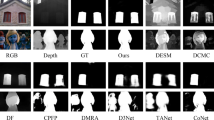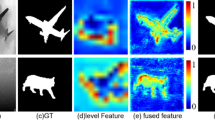Abstract
In recent years, RGB-D based salient object detection has received increasing attention. Most of the previous models are based on early fusion and late fusion to fuse the input RGB-D images. Such an approach cannot effectively explore the complementary information on RGB-D images, and thus information loss and incomplete fusion can occur. To address these problems, we propose a novel framework for RGB-D salient object detection (DEANet). Our framework uses Siamese networks to extract features of RGB-D images to mine the similarity between the two modal data onto a shared-weight manner. Specifically, we propose the Channel-Spatial Fusion Block (CSF) for feature condensation of the extracted Depth features, which can capture the spatial and channel dependencies on RGB-D images from both spatial and dimensional perspectives, thus better mining the complementary information between the two modal images and enables the thoroughness and completeness of the features for which useful information is extracted. In addition, we propose an edge-optimization loss (EL) to obtain smoother salient object edges by supervising the edges of the objects. Comprehensive experiments on four popular evaluation metrics show that our DEANet is able to generate RGB-D saliency detectors with high robustness and generalization ability. In particular, DEANet outperforms thirteen current state-of-the-art methods in terms of four evaluation metrics on six challenging datasets.
Access this chapter
Tax calculation will be finalised at checkout
Purchases are for personal use only
Similar content being viewed by others
References
Chen, L.-C., Yuille, A.L.: Deeplab: semantic image segmentation with deep convolutional nets, atrous convolution, and fully connected crfs. IEEE Trans. Pattern Anal. Mach. Intell. 40, 834–848 (2018)
Cheng, Y., Cao, X.: Depth enhanced saliency detection method. In: International Conference on Internet Multimedia Computing and Service, pp. 23–27 (2014)
Cheng, M.-M., Hu, S.M.: Global contrast based salient region detection. IEEE Trans. Pattern Anal. Mach. Intell. 37, 569–582 (2015)
Chopra, S., LeCun, Y.: Learning a similarity metric discriminatively, with application to face verification. In: International Conference on Computer Vision and Pattern Recogintion, pp. 539–546 (2005)
Cong, R., Ling, N.: HSCS: hierarchical sparsity based co-saliency detection for RGBD images. IEEE Trans. Multimedia 21, 1660–1671 (2019)
Cong, R., Hou, C.: Saliency detection for stereoscopic images based on depth confidence analysis and multiple cues fusion. IEEE Sig. Process. Lett. 23, 819–823 (2016)
Fan, D.-P., Borji, A.: Structure-measure: a new way to evaluate foreground maps. In: IEEE International Conference on Computer Vision, pp. 4558–4567 (2017)
Fan, D.P., Borji, A.: Enhanced-alignment measure for binary foreground map evaluation. In: Proceedings of the Twenty-Ninth International Joint Conference on Artificial Intelligence, pp. 698–704 (2018)
Fan, D.P., Cheng, M.M.: Rethinking RGB-D salient object detection: models, datasets, and large-scale benchmarks. CoRR arXiv:1907.06781 (2019)
Feng, D.P., McCarthy, C.: Local background enclosure for RGB-D salient object detection. In: International Conference on Computer Vision and Pattern Recogintion, pp. 2343–2350 (2016)
Fu, K., Zhu, C.: Siamese network for RGB-D salient object detection and beyond. CoRR arXiv:2008.12134 (2020)
Han, J., Li, X.: CNNS-based RGB-D saliency detection via cross-view transfer and multiview fusion. IEEE Trans. Cybern. 48, 3171–3183 (2018)
Hou, Q., Torr, P.H.S.: Deeply supervised salient object detection with short connections. IEEE Trans. Pattern Anal. Mach. Intell. 41, 815–828 (2019)
Jiang, Z., Davis, L.S.: Submodular salient region detection. In: International Conference on Computer Vision and Pattern Recogintion, pp. 2043–2050 (2013)
Ju, R., Wu, G.: Depth saliency based on anisotropic center-surround difference. In: IEEE International Conference on Image Processing, pp. 1115–1119 (2014)
Li, G., Yu, Y.: Visual saliency based on multiscale deep features. In: International Conference on Computer Vision and Pattern Recogintion, pp. 5455–5463 (2015)
Li, G., Zhu, C.: A three-pathway psychobiological framework of salient object detection using stereoscopic technology. In: IEEE International Conference on Computer Vision, pp. 3008–3014 (2017)
Li, N., Yu, J.: Saliency detection on light field. In: IEEE Transactions on Pattern Analysis and Machine Intelligence, pp. 2806–2813 (2014)
Liang, F., Qing, L.: Stereoscopic saliency model using contrast and depth-guided-background prior. Neurocomputing 275, 2227–2238 (2018)
Liu, N., Han, J.: Dhsnet: deep hierarchical saliency network for salient object detection. In: International Conference on Computer Vision and Pattern Recogintion, pp. 678–686 (2016)
Liu, N., Han, J.: Learning selective self-mutual attention for RGB-D saliency detection. In: International Conference on Computer Vision and Pattern Recognition, pp. 13753–13762 (2020)
Niu, Y., Liu, F.: Leveraging stereopsis for saliency analysis. In: International Conference on Computer Vision and Pattern Recogintion, pp. 454–461 (2012)
Peng, H., Ji, R.: Rgbd salient object detection: A benchmark and algorithms. In: IEEE International Conference on Computer Vision, pp. 92–109 (2014)
Piao, Y., Lu, H.: Depth-induced multi-scale recurrent attention network for saliency detection. In: IEEE International Conference on Computer Vision, pp. 7253–7262 (2019)
Qu, L., Yang, Q.: Rgbd salient object detection via deep fusion. IEEE Trans. Image Process. 26, 2274–2285 (2017)
Quo, J., Bei, J.: Salient object detection for RGB-D image via saliency evolution. In: IEEE International Conference on Multimedia and Expo, pp. 1–6 (2016)
Song, H., Ren, T.: Depth-aware salient object detection and segmentation via multiscale discriminative saliency fusion and bootstrap learning. IEEE Trans. Image Process. 26, 4204–4216 (2017)
Szegedy, C., Wojna, Z.: Rethinking the inception architecture for computer vision. In: International Conference on Computer Vision and Pattern Recogintion, pp. 2818–2826 (2016)
Wang, N., Gong, X.: Adaptive fusion for RGB-D salient object detection. IEEE Access 7, 55277–55284 (2019)
Xie, S., He, K.: Aggregated residual transformations for deep neural networks. In: IEEE Conference on Computer Vision and Pattern Recognition, pp. 5987–5995 (2017)
Yang, C., Yang, M.H.: Saliency detection via graph-based manifold ranking. In: International Conference on Computer Vision and Pattern Recogintion, pp. 3166–3173 (2013)
Zhang, Z., Fan, D.P.: Bilateral attention network for RGB-D salient object detection. IEEE Trans. Image Process. 30, 1949–1961 (2021)
Zhao, J., Zhang, L.: Contrast prior and fluid pyramid integration for RGBD salient object detection. In: International Conference on Computer Vision and Pattern Recogintion, pp. 3927–3936 (2019)
Zhu, C., Wang, R.: An innovative salient object detection using center-dark channel prior. In: IEEE International Conference on Computer Vision, pp. 1509–1515 (2017)
Acknowledgment
This work is financially supported by the National Natural Science Foundation of China (61602286, 61976127) and the Special Project on Innovative Methods (2020IM020100).
Author information
Authors and Affiliations
Corresponding author
Editor information
Editors and Affiliations
Rights and permissions
Copyright information
© 2021 Springer Nature Switzerland AG
About this paper
Cite this paper
Sheng, X. et al. (2021). Saliency Detection Framework Based on Deep Enhanced Attention Network. In: Mantoro, T., Lee, M., Ayu, M.A., Wong, K.W., Hidayanto, A.N. (eds) Neural Information Processing. ICONIP 2021. Lecture Notes in Computer Science(), vol 13111. Springer, Cham. https://doi.org/10.1007/978-3-030-92273-3_23
Download citation
DOI: https://doi.org/10.1007/978-3-030-92273-3_23
Published:
Publisher Name: Springer, Cham
Print ISBN: 978-3-030-92272-6
Online ISBN: 978-3-030-92273-3
eBook Packages: Computer ScienceComputer Science (R0)




